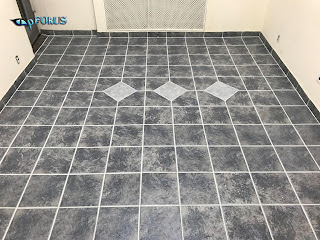Why Should you Seal the Grout on your Travertine/Marble Floors?
You might be investing high amounts for travertine/marble stone on your floors to enhance the look of your interiors. But over a period of time, these floors start to look dull and worn out. The main reason behind this is because you ignore the grout. Grout - the mixture of cement and sand filled in between two tiles is porous. The porosity makes it absorb water and moisture into its surface, thereby giving an excellent breeding ground for mold and mildew to develop. To prevent such occurrences, you should use a travertine/marble grout sealer to keep your grout intact.
How does this Sealer Work?
To give you a better idea of how this sealer works, first look at the above image. You will find the grout cracked and missing in some places and looking stained and dirty. This dirty grout is ruining the look of the travertine floor.
Now, look at the image below.
In the above image, the grout has been cleaned, restored and sealed with a travertine/marble grout sealer.
This wonder sealer from pFOkUS has brought a revolutionary change in floor maintenance. pFOkUS sealer is a very efficient colored grout sealer, which is available in 40 colors. These colors are mostly earthy and neutral tones found in tiles. It is a pigmented grout sealing system that is built on a rock-solid 2-part solvent titanium resin/epoxy foundation. It is made in such a way that it can cover all grout in just one coat. It is suitable for sealing both sanded and unsanded grout.
Reasons Why You Should Seal Your Grout with a Good Sealer:
An unsealed grout easily wears off or cracks, giving a very un-maintained appearance to the travertine/marble flooring.
The place from where the grout cracks tends to store water. Stagnant water leads to mold breeding.
Porous grout also leads to mold and mildew formation.
If the grout wears off, the tile may come off loose in the absence of a good joint between them. This can hurt anyone walking barefoot on the travertine/marble flooring.
How to Apply Travertine/Marble Grout Sealer?
After the grout has dried properly, you can apply the epoxy grout sealer.
Apply the sealant in a smooth and even coat over the grout lines.
After applying Caponi on the grout lines, you can wipe off the excess build-up using an alcohol-based paint thinner.
How to Seal Natural Stone?
Once you have sealed your grout, the next step should be to seal your natural stone using a good marble or travertine/granite sealer. Travertine, marble, slate or granite natural stone need to be sealed with a good quality stone tile sealer to preserve their integrity. It is easy to seal natural stone using pFOkUS sealer - Celine. Once the stone and grout are cleaned, cracks repaired and grout sealed, you can seal your natural stone using Celine. A good stone grout sealer forms a hydrophobic layer on your stone, thereby making it water-resistant.
pFOkUS has an incredible range of tile and grout sealing products and they are all natural stone approved. Our products are manufactured after years of research in the laboratories and are even recommended by D’Sapone - one of the leading tile and grout restoration services provider companies in the US.




Comments
Post a Comment